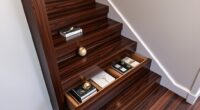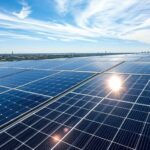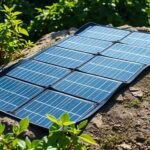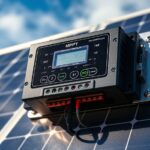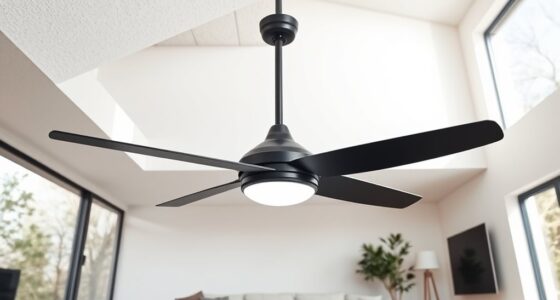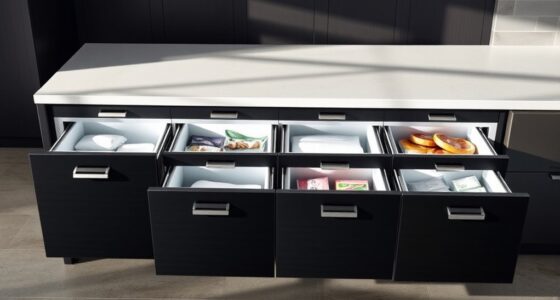If you’re looking for the best power optimizer solar strings for maximum efficiency in 2025, I recommend weighing options like module-level optimizers with MPPT capabilities, high wattage support, and waterproof ratings such as IP67/IP68. Top choices include the 600W, 1500V MPPT optimizer, LICHIFIT’s waterproof models, and Y&H’s high-efficiency units. Don’t forget to take into account installation ease, environmental durability, and system compatibility. Keep reading to discover detailed features for each option and find the perfect fit.
Key Takeaways
- Prioritize optimizers with high efficiency (up to 99.5%) and IP67/IP68 ratings for durability and maximum energy gains.
- Select models compatible with high voltage systems (up to 1500V) for scalable, future-proof installations.
- Consider optimizers supporting real-time MPPT monitoring and remote system management features.
- Choose units with robust protections against dust, snow, and harsh weather to ensure long-term outdoor performance.
- Evaluate compatibility with existing panels and inverters to optimize overall system efficiency and warranty coverage.
Module-Level PV Power Optimizer (600W, 1500V, MPPT, Real-time Monitoring)
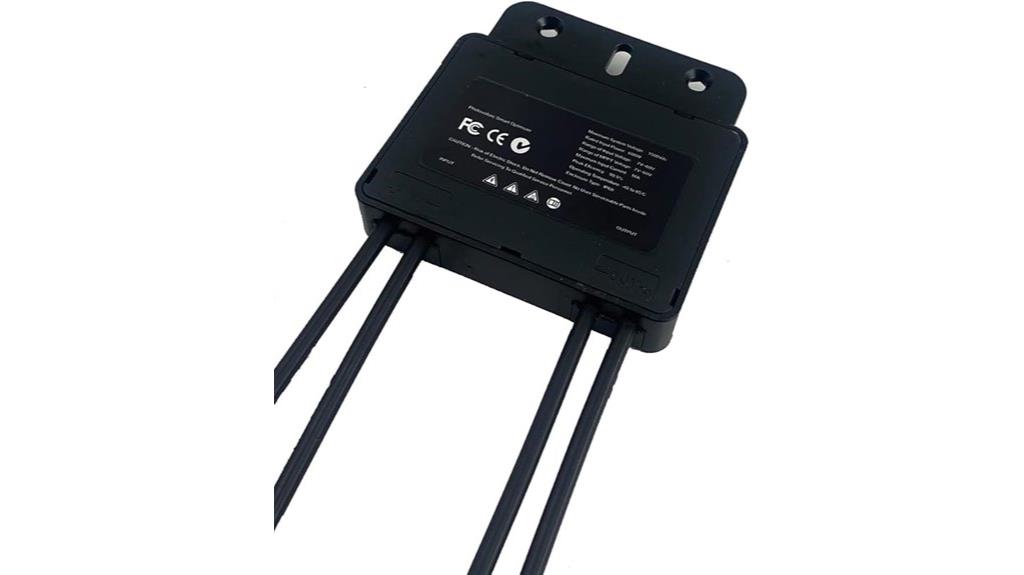
If you’re looking to maximize your solar system’s efficiency, the Module-Level PV Power Optimizer is an excellent choice, especially with its 600W output and 1500V system voltage. It offers real-time MPPT monitoring, helping you optimize each panel’s performance individually. This reduces power loss caused by shading, dust, or orientation differences by up to 25%. Plus, it enhances system reliability by eliminating hot spots and extending PV module lifespan. Its design allows more modules per string, making system setup more flexible. Overall, it improves energy generation and lowers your Levelized Cost of Energy, making your investment more cost-effective over time.
Best For: homeowners and solar system installers seeking to maximize energy efficiency, system reliability, and flexible design through real-time panel monitoring and enhanced power management.
Pros:
- Reduces power loss caused by shading, dust, snow, and orientation differences by up to 25%
- Extends PV module lifespan by eliminating hot spots and improving system reliability
- Supports flexible system design with the ability to connect more modules per string
Cons:
- May require initial investment in monitoring and optimization technology
- Compatibility with existing systems needs to be verified for seamless integration
- Installation and setup may require specialized knowledge or professional assistance
LICHIFIT Solar Optimizer MPPT 320W P320-5NC4ARS
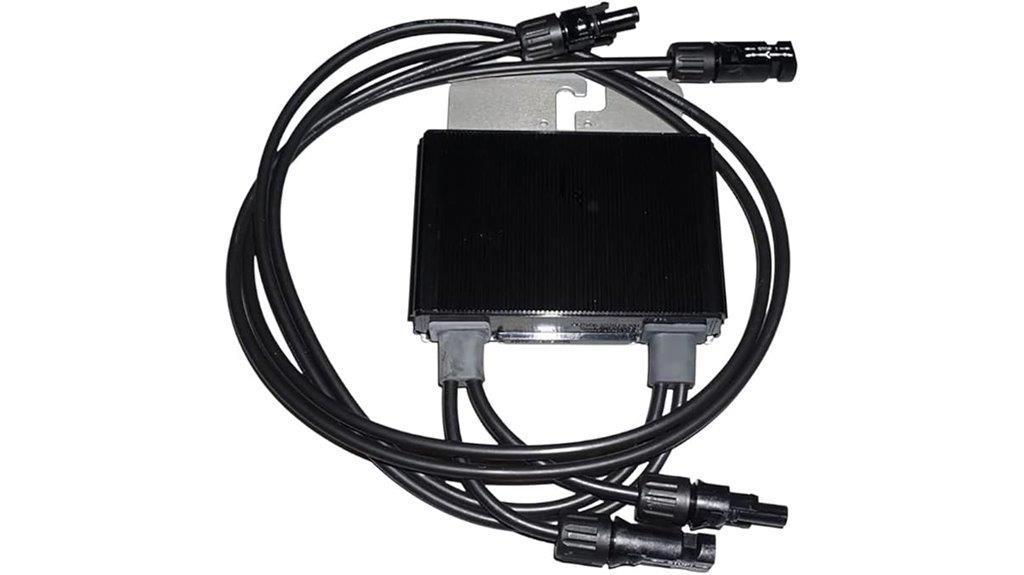
The LICHIFIT Solar Optimizer MPPT 320W P320-5NC4ARS stands out for those installing SolarEdge DC PV panels, thanks to its seamless compatibility and high efficiency. Designed specifically for SolarEdge systems, it features a durable, waterproof IP68/NEMA6P housing and high-quality aluminum alloy for heat dissipation. With a 320W capacity and a wide voltage range, it adapts well to various setups. While most users report stable performance, some have raised concerns about authenticity and labeling issues. Proper pairing requires serial numbers, so verifying product authenticity before installation is essential to guarantee smooth operation and warranty coverage.
Best For: homeowners and solar system installers seeking a durable, compatible optimizer for SolarEdge DC PV panels with high efficiency and reliable performance.
Pros:
- Fully waterproof IP68/NEMA6P housing ensures durability in harsh environmental conditions
- Wide voltage range adapts to various solar panel configurations
- High-quality materials like aluminum alloy improve heat dissipation and longevity
Cons:
- Some units may arrive without serial labels, complicating installation and system mapping
- Concerns regarding product authenticity and previous use reported by customers
- Serial numbers required for pairing and warranty verification may be missing from some units
Solar Panel Optimizer (MPPT PV Overload Protection Accessory)
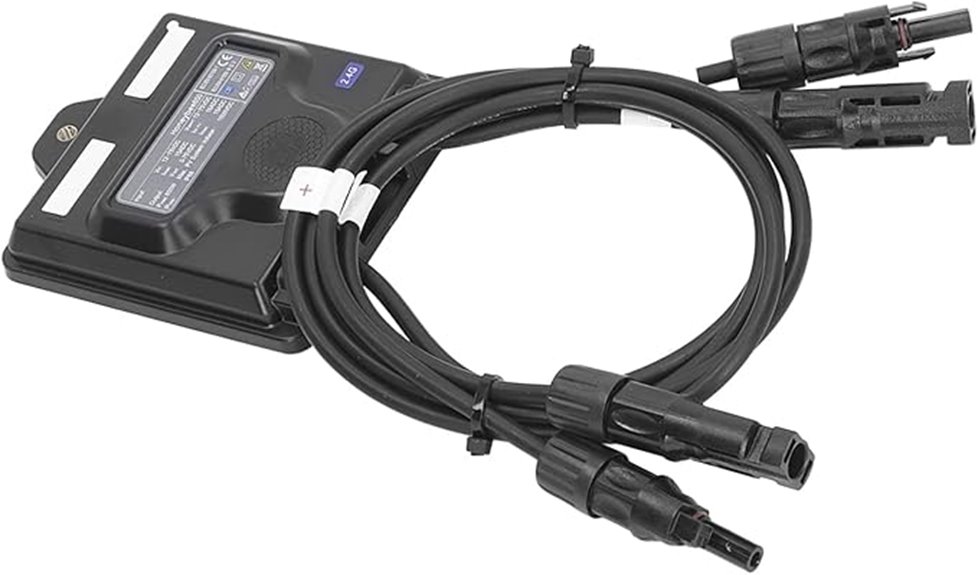
A solar panel optimizer with MPPT PV overload protection is crucial for maximizing the efficiency of photovoltaic systems, especially in outdoor environments. It optimizes individual PV module output, boosting overall system power by up to 25%. Built to handle voltages up to 1500V DC, it ensures reliable, long-term performance. The device features overload, overcurrent, and over-temperature protections to safeguard your system against damage. Made from durable materials and rated IP68 for outdoor use, it’s easy to install and supports multiple communication modes. This accessory provides stability, safety, and increased energy production, making it a indispensable component for efficient solar setups.
Best For: homeowners, solar farm operators, and renewable energy enthusiasts seeking to maximize photovoltaic system efficiency and ensure long-term reliable performance.
Pros:
- Enhances system power output by 5-25%, increasing energy yield
- Supports high voltages up to 1500V DC, suitable for large-scale installations
- Equipped with multiple communication options and robust protection features for outdoor use
Cons:
- Installation may require technical knowledge despite being straightforward
- Compatibility limited to systems within specified voltage and current ranges
- The device’s effectiveness depends on proper integration with existing solar setups
Y&H Module-Level PV Power Optimizer (600W, 1500V, MPPT)
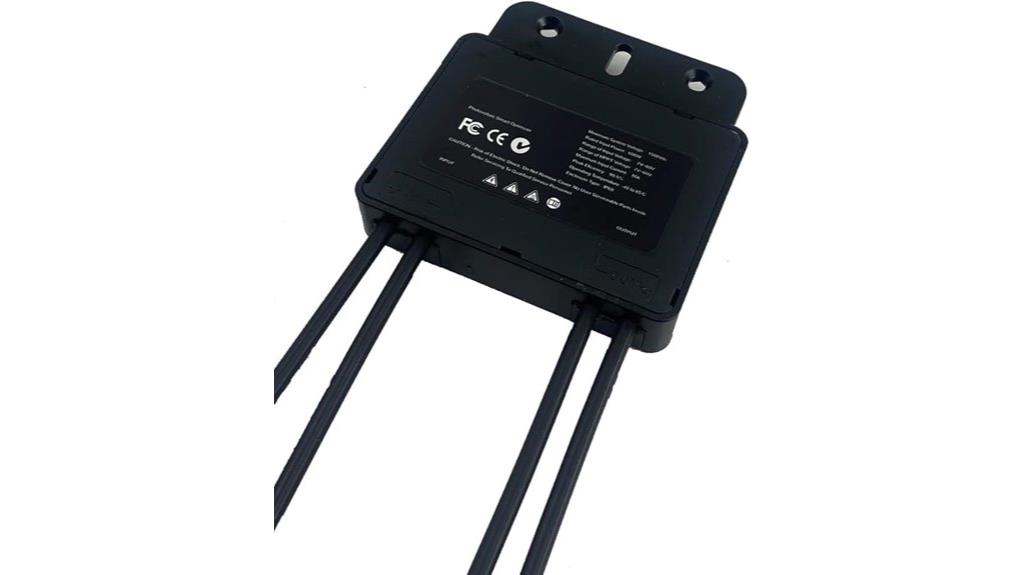
Designed for outdoor installations demanding high efficiency, the Y&H Module-Level PV Power Optimizer stands out with its impressive 99.5% conversion efficiency and compatibility with system voltages up to 1500V. It delivers a maximum output power of 600W, with a maximum current of 16A and an MPPT voltage range of 7-60V, optimizing power even under shading or dust. Its IP67 rating ensures durability in harsh environments, while its compact size and lightweight design make installation straightforward. By reducing power loss and hot spots, it enhances system reliability, extends PV module lifespan, and boosts overall energy production for maximum efficiency in 2025.
Best For: homeowners and commercial solar system installers seeking high-efficiency, durable, and easy-to-install module-level power optimization solutions for outdoor PV installations.
Pros:
- High conversion efficiency of 99.5% maximizes energy output and reduces energy loss.
- Compatibility with system voltages up to 1500V allows for flexible and scalable system design.
- IP67 ingress protection ensures durability against harsh environmental conditions like dust, snow, and rain.
Cons:
- Limited maximum output power of 600W may require multiple units for larger systems.
- The device’s size, while compact, still requires proper space allocation during installation.
- As a specialized component, it may involve higher upfront costs compared to traditional string inverters.
240FT Solar String Lights with Remote, Waterproof G40 LED Bulbs
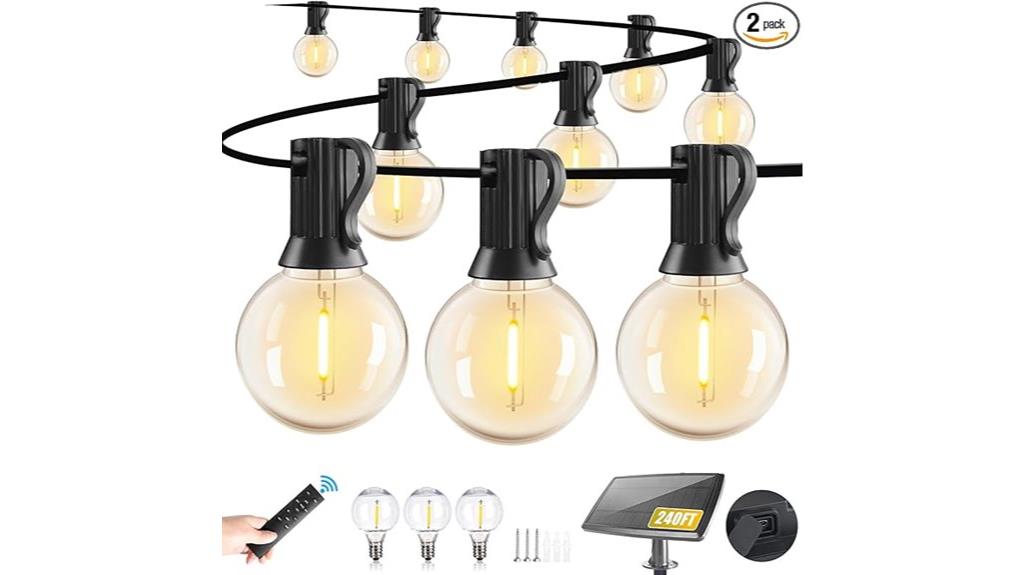
If you’re looking for a solar string lights option that combines ease of use with durability, FT Solar String Lights with Remote and Waterproof G40 LED Bulbs stand out. These 240-foot-long lights feature 80 LED bulbs plus spares, no outlets needed, and a highly efficient solar panel that fully charges in 8 hours. They provide over 20 hours of light nightly, even in cloudy weather, thanks to dual charging via solar or USB. The remote control offers adjustable brightness, multiple modes, and timers, making customization simple. Built with waterproof, shatterproof components, they’re perfect for year-round outdoor use, adding cozy, charming illumination to any space.
Best For: outdoor homeowners, event organizers, and anyone seeking durable, eco-friendly lighting solutions for gardens, patios, or special outdoor occasions.
Pros:
- Long 240-foot length with 80 LED bulbs plus spares for extensive coverage.
- Highly efficient solar panel with dual charging options ensures reliable power in all weather conditions.
- Remote control with adjustable brightness, multiple modes, and timers offers convenient customization.
Cons:
- May require direct sunlight for optimal charging, limiting placement options in shaded areas.
- Slightly higher upfront cost compared to traditional string lights due to advanced features and durable materials.
- Bulb spacing and length may not suit very small or narrow outdoor spaces.
10KW Solar Grid Tie Inverter with 75-550V DC Input and 240V AC Output
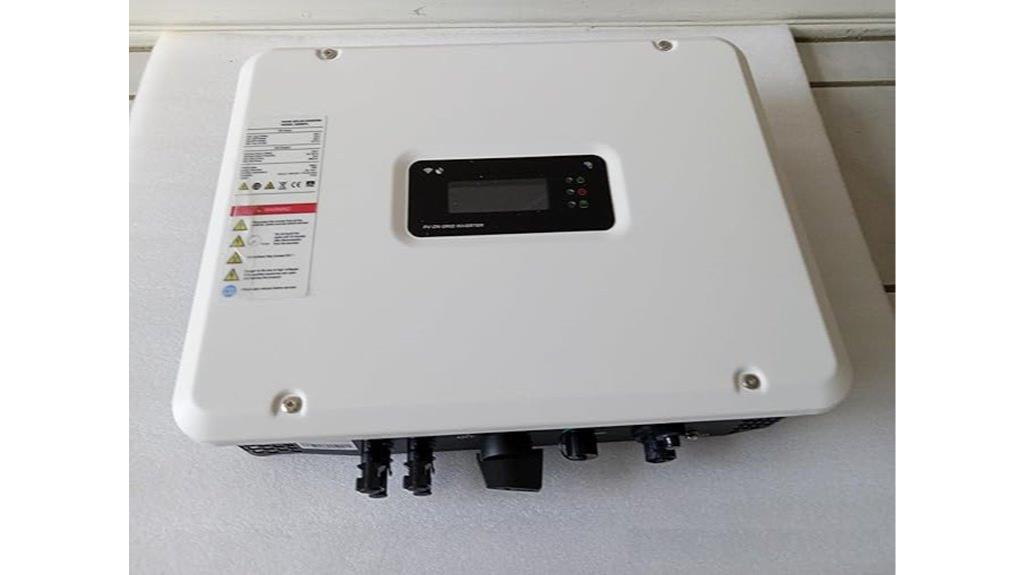
The KW Solar Grid Tie Inverter with 75-550V DC Input and 240V AC Output stands out as an ideal choice for residential and commercial solar installations seeking high efficiency and reliable grid integration. It offers a 10KW nominal power, supporting up to 15KW input, with a maximum DC voltage of 550V. Its efficiency peaks at 97.5%, and MPPT efficiency reaches 99.9%. Designed for outdoor use, it features IP65 waterproof protection, natural convection cooling, and supports temperatures from -25°C to +60°C. Built-in WiFi allows real-time monitoring, while advanced safety features guarantee reliable operation and system longevity. This inverter simplifies installation and future upgrades, making it perfect for maximizing solar system performance.
Best For: Homeowners and small to medium-sized commercial solar system installers seeking a reliable, high-efficiency grid-tie inverter with flexible installation options and advanced monitoring features.
Pros:
- High efficiency peak of 97.5% and MPPT efficiency up to 99.9% for optimal energy harvest.
- IP65 waterproof and dustproof design suitable for outdoor installation in various climates.
- Built-in WiFi and user-friendly app for real-time monitoring and system management.
Cons:
- Heavy weight of approximately 11kg may require sturdy mounting solutions.
- Limited to 240V AC output, which may not be compatible with all grid standards.
- First available in July 2025, so some users might face initial availability or support delays.
SUNTHIN 24ft Solar String Lights with Waterproof LED Bulbs
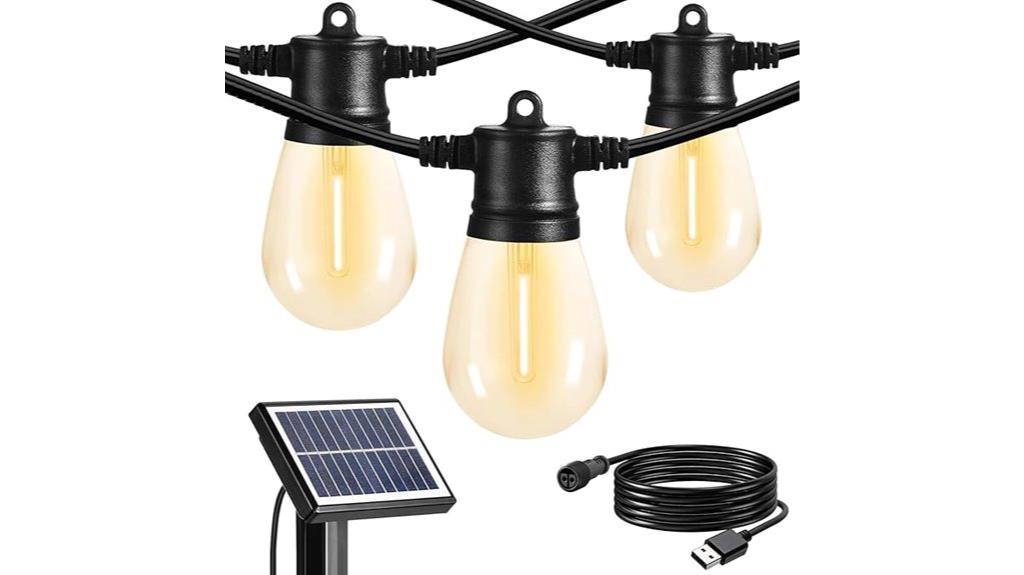
SUNTHIN 24ft Solar String Lights with Waterproof LED Bulbs stand out as an excellent choice for anyone seeking durable, weatherproof outdoor lighting. These lights feature auto on/off functionality, saving energy and eliminating electricity costs. Their advanced LED technology ensures a lifespan of up to 10,000 hours, while waterproof and shatterproof bulbs guarantee reliable performance in rain, snow, or shine. Perfect for patios, gardens, and outdoor events, they’re portable and easy to install without needing outlets or cords. Eco-friendly and low-maintenance, these solar string lights offer a stylish, sustainable lighting solution that enhances any outdoor space year-round.
Best For: outdoor homeowners, event organizers, and campers seeking durable, eco-friendly lighting solutions for various weather conditions.
Pros:
- Auto on/off functionality saves energy and reduces electricity costs
- Waterproof and shatterproof bulbs ensure reliable performance in all weather
- Easy to install and portable, perfect for outdoor spaces and trips
Cons:
- Limited to solar power, which may affect brightness on cloudy or short winter days
- May require sufficient sunlight exposure for optimal charging and performance
- Battery and solar panel maintenance needed over time to ensure longevity
HJQ 60FT Solar String Lights Outdoor Waterproof with Remote & USB

For those seeking versatile outdoor lighting that combines durability with convenience, the HJQ 60FT Solar String Lights stand out. With waterproof, shatterproof bulbs and 20+1 LEDs, they’re perfect for gardens, patios, weddings, or parties. The lights offer three modes and are dimmable via remote, allowing easy customization. A 3600mAh battery provides 10-20 hours of lighting, charged by solar or USB, ensuring reliable use even on cloudy days. Rated IP65, these lights withstand harsh weather. Their durable design, combined with user-friendly controls and flexible charging options, makes them a top choice for creating cozy, romantic outdoor atmospheres.
Best For: outdoor enthusiasts and hosts seeking durable, customizable, and energy-efficient lighting for gardens, patios, weddings, or parties.
Pros:
- Waterproof, shatterproof bulbs suitable for all weather conditions
- Multiple lighting modes and dimming options via remote control for easy customization
- Dual charging methods (solar and USB) ensure reliable operation regardless of weather
Cons:
- Requires sunlight or USB power for optimal charging, which may be limited in shaded areas
- Slightly longer setup time due to installation of solar panel and string arrangement
- Battery capacity may need replacement after extended use to maintain performance
10 FT 10AWG Solar Panel Extension Cable
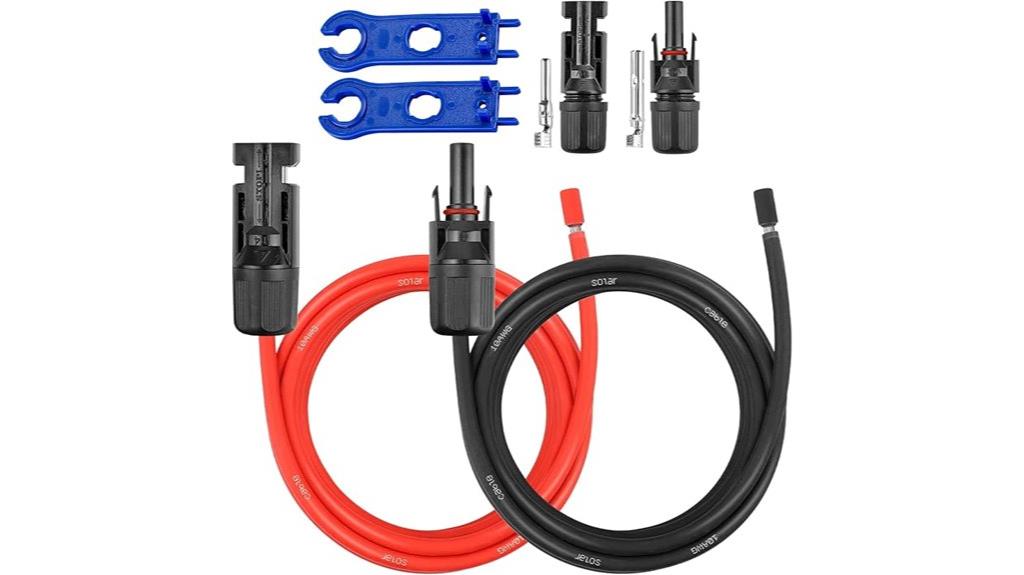
A 10 ft 10AWG solar panel extension cable stands out as an essential accessory for maximizing your solar setup’s efficiency and reliability. Its tinned copper conductors ensure excellent conductivity, reducing power loss and boosting charging efficiency. The XLPE insulation offers outstanding durability against extreme outdoor conditions, UV rays, and moisture, extending the cable’s lifespan. Waterproof IP68 connectors with built-in locks provide secure, stable connections even in harsh weather. Designed for versatility, it can connect solar panels to charge controllers, RVs, boats, or power stations, and features pre-wired MC4 connectors for easy, plug-and-play installation. This cable guarantees dependable performance and long-term durability.
Best For: DIY solar enthusiasts, RV owners, and boat operators seeking reliable, durable, and easy-to-install solar extension cables for outdoor applications.
Pros:
- High-quality 10 AWG tinned copper conductors for excellent conductivity and minimal power loss
- Robust XLPE insulation with UV, waterproof, and temperature resistance for long outdoor lifespan
- Easy plug-and-play design with pre-wired MC4 connectors and included tools for quick installation
Cons:
- Limited to 10 feet length; may require longer cables for larger setups
- Slightly heavier due to thick gauge wiring, which might be less flexible in tight spaces
- Requires some basic knowledge for proper crimping and connection, which might be challenging for complete beginners
Factors to Consider When Choosing a Power Optimizer Solar String

When choosing a power optimizer solar string, I focus on compatibility with my panels and ensuring it can handle my system’s power output. I also consider how durable it is against environmental conditions and how easy it is to install. Finally, I look for monitoring features that help me keep track of performance and efficiency.
Compatibility With Panels
Choosing a power optimizer that matches your solar panels‘ specifications is essential for ensuring system compatibility and ideal performance. I always check that the optimizer’s voltage and current ratings align with my panels to avoid issues. It’s important to verify that the optimizer supports the system voltage—up to 1500V for commercial setups or 1000V for residential—so everything runs smoothly. I also make sure the MPPT voltage range fits my panels’ operating voltage for maximum energy harvest. Additionally, I confirm that the connector types, like MC4 or proprietary options, are compatible with my wiring. Finally, I consider whether the optimizer supports the number of panels in my string, which helps optimize performance and simplifies installation. Compatibility is vital for a reliable, efficient solar system.
Power Output Capacity
The power output capacity of a power optimizer determines the maximum wattage it can handle, making it a critical factor in selecting the right model. Typically, this capacity ranges from 320W to 600W or more. Matching the optimizer’s capacity with your PV modules’ wattage is essential for ideal performance and avoiding system overloads. If you push an optimizer beyond its rated capacity, efficiency drops, and there’s a risk of damage or failure. When planning your system, consider the total power output from all optimizers to meet your energy goals. Choosing an optimizer with a higher capacity than your current modules also provides room for future expansion, maximizing your investment and energy production over time.
Environmental Durability
Since outdoor conditions can be unpredictable and harsh, guaranteeing your power optimizer can withstand environmental challenges is essential. I look for models with high IP ratings, like IP65 or IP67, which offer strong resistance to dust, water, and other elements. Materials matter too—UV-resistant plastics, corrosion-resistant metals, and sealed enclosures help extend lifespan and maintain performance. I also check the operating temperature range, ideally from -40°C to +85°C, to ensure reliable operation during temperature fluctuations. Durable power optimizers reduce maintenance needs and minimize system downtime, keeping energy production consistent over time. Prioritizing environmental durability means investing in equipment that can handle the elements, ultimately maximizing your solar system’s efficiency and longevity in real-world outdoor conditions.
Installation Ease
When selecting a power optimizer for your solar string, ease of installation should be a top priority. I recommend choosing models that are lightweight and compact, making setup quick and effortless. Look for units with clearly labeled connectors and simple wiring instructions—this minimizes errors and saves time. Opt for plug-and-play features whenever possible, as they reduce the need for specialized tools or complex configurations. Compatibility is vital; ensure the optimizer works seamlessly with your existing solar panels and system components. Finally, select models with durable, weatherproof enclosures like IP65 or IP67 ratings, so you can install them outdoors without extra protective gear. Prioritizing these factors makes installation smoother, quicker, and ultimately more cost-effective.
Monitoring Features
Choosing a power optimizer with robust monitoring features is essential for maximizing your solar system’s efficiency. Good monitoring allows me to track each panel’s performance in real time, so I can quickly spot issues like shading or faults. High-quality systems provide detailed data, including voltage, current, and power output, which helps optimize overall performance. Advanced features let me access this information remotely through mobile apps or web portals, making management convenient. Accurate monitoring data also supports predictive maintenance, reducing downtime and extending component lifespan. When selecting a power optimizer, I look for compatibility with monitoring platforms and easy data interpretation, as these factors make troubleshooting more straightforward and keep my system running at peak efficiency.
Voltage and Current Limits
Ensuring that the power optimizer’s voltage and current limits match your solar string’s specifications is essential for safe and efficient operation. I always check that the optimizer’s maximum input voltage equals or exceeds my total panel voltage to prevent overvoltage issues. It’s also critical that the maximum input current is higher than the combined current of all panels, avoiding overloads. Additionally, I verify that the rated output voltage and current align with my inverter’s requirements to maximize performance. Exceeding these limits can cause system inefficiencies, shutdowns, or even damage components. Properly matching voltage and current specs not only guarantees safety but also boosts the system’s reliability and long-term durability. Paying attention to these limits helps me maintain peak operation and avoid costly mistakes.
Cost and Warranty
Evaluating the cost and warranty options for a power optimizer is essential to getting the best value over its lifespan. I recommend considering the total system cost, including installation, maintenance, and replacement parts, to understand its true value. Check the warranty duration and coverage details—aim for at least 10-25 years—that include repairs or replacements for defects or performance issues. Make sure the warranty covers both hardware and software support for thorough protection. Generally, higher-priced optimizers tend to offer more extensive warranties, which can save you money long-term. Always review the manufacturer’s warranty conditions, including claim procedures, exclusions, and whether authorized service is required. This way, you’ll ensure your investment remains protected and cost-effective throughout its lifespan.
Size and Weight
The size and weight of a power optimizer play a crucial role in how seamlessly it integrates into your solar system. A compact, lightweight optimizer—typically under 1.5 pounds and measuring less than 5 inches in length and width—makes installation easier and more flexible, especially in tight spaces or on rooftops. Lighter models are simpler to handle and reduce strain during setup. Smaller dimensions allow discreet placement behind panels or in confined enclosures, maintaining aesthetic appeal. Conversely, larger or bulkier optimizers may offer extra features but can complicate installation and demand more mounting space. Considering size and weight ensures that your optimizer fits well within your system’s physical design, streamlining installation and maximizing overall efficiency.
Frequently Asked Questions
How Do Power Optimizers Improve Solar String System Efficiency?
Power optimizers boost solar string system efficiency by individually tracking each panel’s maximum power point, which prevents shading or dirt from reducing overall output. They optimize performance at the module level, ensuring each panel operates at its peak, rather than relying on a single string inverter. This way, I get more energy from my system, especially when panels face different directions or partial shading occurs.
Are There Compatibility Issues With Different Inverter Brands?
Think of inverter and optimizer compatibility like fitting puzzle pieces together. I once installed a system where I double-checked compatibility first, saving me headaches later. Most modern optimizers work well with popular inverters, but some brands have proprietary tech, causing issues. Always verify compatibility before installation, as mixing incompatible components can reduce efficiency and cause system failures. It’s worth the time to make sure all parts sync perfectly.
What Maintenance Is Required for Power Optimizer Solar Strings?
I regularly inspect my power optimizer solar strings for dirt, debris, and any physical damage, ensuring all connections are secure. I also check for any error messages via the monitoring system and clean the modules if dirt accumulates. It’s important to keep the system free from shading and to schedule professional inspections annually to maintain peak performance and catch potential issues early.
How Do Outdoor Conditions Affect Optimizer Performance?
Outdoor conditions can considerably impact optimizer performance. I’ve noticed that dirt, dust, and debris on the panels reduce efficiency, so I clean them regularly. Extreme temperatures, both hot and cold, can also affect electronics, so I make sure proper ventilation and shading when needed. Additionally, shading from trees or nearby structures causes power dips. By monitoring weather and keeping panels clean, I maximize their performance and longevity.
Can Optimizers Be Installed on Existing Solar Panel Systems?
Yes, you can install optimizers on existing solar panel systems. I’ve done it myself, and it’s a great way to boost efficiency without replacing your entire setup. Most optimizers are compatible with various panel types and wiring configurations. I recommend consulting a professional to guarantee proper installation and maximize benefits. It’s a smart upgrade that can improve your system’s performance and energy output.
Conclusion
Choosing the right power optimizer solar string is like picking the perfect compass for a journey—essential for maximizing efficiency and avoiding pitfalls. By considering factors like wattage, voltage, and monitoring features, you can guarantee your solar setup performs at its best. Remember, the right optimizer isn’t just a tool; it’s your partner in harnessing the sun’s power. So, take your time, choose wisely, and watch your solar energy savings grow like a blooming garden.

